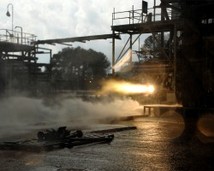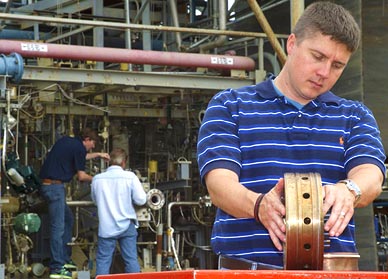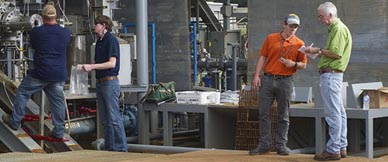/ News

NASA Tests Limits of 3-D Printing with Powerful Rocket Engine Check
NASA.gov – The largest 3-D printed rocket engine component NASA ever has tested blazed to life Thursday, Aug. 22 during an engine firing that generated a record 20,000 pounds of thrust.
This test is a milestone for one of many important advances the agency is making to reduce the cost of space hardware. Innovations like additive manufacturing, or 3-D printing, foster new and more cost-effective capabilities in the U.S. space industry.
The component tested during the engine firing, an injector, delivers propellants to power an engine and provides the thrust necessary to send rockets to space. During the injector test, liquid oxygen and gaseous hydrogen passed through the component into a combustion chamber and produced 10 times more thrust than any injector previously fabricated using 3-D printing.
 Propulsion systems engineer Greg Barnett prepares a rocket injector for a hot fire test at NASA’s Marshall Space Flight Center. (NASA.gov image)
Propulsion systems engineer Greg Barnett prepares a rocket injector for a hot fire test at NASA’s Marshall Space Flight Center. (NASA.gov image)
“This successful test of a 3-D printed rocket injector brings NASA significantly closer to proving this innovative technology can be used to reduce the cost of flight hardware,” said Chris Singer, the director of the Engineering Directorate at NASA’s Marshall Space Flight Center in Huntsville Ala.
The component was manufactured using selective laser melting. This method built up layers of nickel-chromium alloy powder to make the complex, subscale injector with its 28 elements for channeling and mixing propellants. The part was similar in size to injectors that power small rocket engines. It was similar in design to injectors for large engines, such as the RS-25 engine that will power NASA’s Space Launch System (SLS) rocket for deep space human missions to an asteroid and Mars.
 NASA engineers prepare to hot-fire test a 3-D printed rocket part on Test Stand 115 at the Marshall Center. (NASA.gov image)
NASA engineers prepare to hot-fire test a 3-D printed rocket part on Test Stand 115 at the Marshall Center. (NASA.gov image)
“This entire effort helped us learn what it takes to build larger 3-D parts — from design, to manufacturing, to testing,” said Greg Barnett, the lead engineer for the project.
“This technology can be applied to any of SLS’s engines, or to rocket components being built by private industry.”
“This entire effort helped us learn what it takes to build larger 3-D parts — from design, to manufacturing, to testing,” said Greg Barnett, the lead engineer for the project.
One of the keys to reducing the cost of rocket parts is minimizing the number of components. This injector had only two parts, whereas a similar injector tested earlier had 115 parts. Fewer parts require less assembly effort, which means complex parts made with 3-D printing have the potential for significant cost savings.
“We took the design of an existing injector that we already tested and modified the design so the injector could be made with a 3-D printer,” explained Brad Bullard, the propulsion engineer responsible for the design of the injector.
“We will be able to directly compare test data for both the traditionally assembled injector and the 3-D printed injector to see if there’s any difference in performance.”
Early data from the test, conducted at pressures up to 1,400 pounds per square inch absolute and at almost 6,000 degrees Fahrenheit, indicate the injector worked flawlessly. In the days to come, engineers will perform computer scans and other inspections to scrutinize the component more closely.
Source: http://spacecoastdaily.com/2013/08/nasa-tests-limits-of-3-d-printing-with-powerful-rocket-engine-check/
/ About us
Founded by Russian entrepreneur Dmitry Itskov in February 2011 with the participation of leading Russian specialists in the field of neural interfaces, robotics, artificial organs and systems.
The main goals of the 2045 Initiative: the creation and realization of a new strategy for the development of humanity which meets global civilization challenges; the creation of optimale conditions promoting the spiritual enlightenment of humanity; and the realization of a new futuristic reality based on 5 principles: high spirituality, high culture, high ethics, high science and high technologies.
The main science mega-project of the 2045 Initiative aims to create technologies enabling the transfer of a individual’s personality to a more advanced non-biological carrier, and extending life, including to the point of immortality. We devote particular attention to enabling the fullest possible dialogue between the world’s major spiritual traditions, science and society.
A large-scale transformation of humanity, comparable to some of the major spiritual and sci-tech revolutions in history, will require a new strategy. We believe this to be necessary to overcome existing crises, which threaten our planetary habitat and the continued existence of humanity as a species. With the 2045 Initiative, we hope to realize a new strategy for humanity's development, and in so doing, create a more productive, fulfilling, and satisfying future.
The "2045" team is working towards creating an international research center where leading scientists will be engaged in research and development in the fields of anthropomorphic robotics, living systems modeling and brain and consciousness modeling with the goal of transferring one’s individual consciousness to an artificial carrier and achieving cybernetic immortality.
An annual congress "The Global Future 2045" is organized by the Initiative to give platform for discussing mankind's evolutionary strategy based on technologies of cybernetic immortality as well as the possible impact of such technologies on global society, politics and economies of the future.
Future prospects of "2045" Initiative for society
2015-2020
The emergence and widespread use of affordable android "avatars" controlled by a "brain-computer" interface. Coupled with related technologies “avatars’ will give people a number of new features: ability to work in dangerous environments, perform rescue operations, travel in extreme situations etc.
Avatar components will be used in medicine for the rehabilitation of fully or partially disabled patients giving them prosthetic limbs or recover lost senses.
2020-2025
Creation of an autonomous life-support system for the human brain linked to a robot, ‘avatar’, will save people whose body is completely worn out or irreversibly damaged. Any patient with an intact brain will be able to return to a fully functioning bodily life. Such technologies will greatly enlarge the possibility of hybrid bio-electronic devices, thus creating a new IT revolution and will make all kinds of superimpositions of electronic and biological systems possible.
2030-2035
Creation of a computer model of the brain and human consciousness with the subsequent development of means to transfer individual consciousness onto an artificial carrier. This development will profoundly change the world, it will not only give everyone the possibility of cybernetic immortality but will also create a friendly artificial intelligence, expand human capabilities and provide opportunities for ordinary people to restore or modify their own brain multiple times. The final result at this stage can be a real revolution in the understanding of human nature that will completely change the human and technical prospects for humanity.
2045
This is the time when substance-independent minds will receive new bodies with capacities far exceeding those of ordinary humans. A new era for humanity will arrive! Changes will occur in all spheres of human activity – energy generation, transportation, politics, medicine, psychology, sciences, and so on.
Today it is hard to imagine a future when bodies consisting of nanorobots will become affordable and capable of taking any form. It is also hard to imagine body holograms featuring controlled matter. One thing is clear however: humanity, for the first time in its history, will make a fully managed evolutionary transition and eventually become a new species. Moreover, prerequisites for a large-scale expansion into outer space will be created as well.
Key elements of the project in the future
• International social movement
• social network immortal.me
• charitable foundation "Global Future 2045" (Foundation 2045)
• scientific research centre "Immortality"
• business incubator
• University of "Immortality"
• annual award for contribution to the realization of the project of "Immortality”.



 LinkedIn
LinkedIn
 LiveJournal
LiveJournal
 Google
Google
 Twitter
Twitter
 Facebook
Facebook
 Я.ру
Я.ру
 ВКонтакте
ВКонтакте
 Mail.ru
Mail.ru